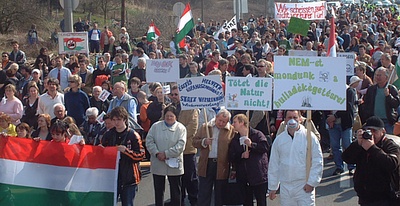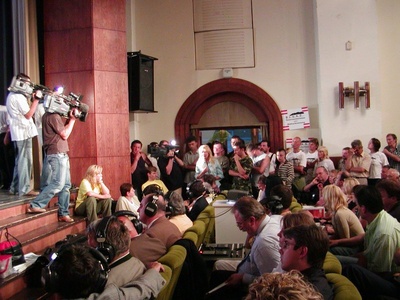March 2007: Heavy blow to the waste incineration industry

 A referendum held in Pusztazámor, unexpected change in Inota, the ever-greatest Hungarian demonstration against waste incinerators in Szentgotthárd. These caused heavy blow to the waste incineration industry, but according to a ministerial case study: new battles are to be fought against opponents of incineration.
A referendum held in Pusztazámor, unexpected change in Inota, the ever-greatest Hungarian demonstration against waste incinerators in Szentgotthárd. These caused heavy blow to the waste incineration industry, but according to a ministerial case study: new battles are to be fought against opponents of incineration.
Inota-Várpalota
Currently, there is only one common waste incinerator operating on the outskirts of Budapest, but a dozen of them is planned to be built. The incinerator planned at Inota has come closest to realisation. It’s future is of great importance. If it were built, it is to be feared that it would set an example and reference to other waste incinerators. The environmental impact assessment of the Inota incinerator is ready by now, and until recent times it seemed that everything is put straight. However, the local governmental elections have led to a change in the situation earlier considered to be unambiguous. The board of local government representatives has announced that it shall seize every opportunity to impede the construction of the waste incinerator. They are in an unfavourable position as the Vice President of Mid-Danube Regional Association for Waste Management has claimed damages of 20 billion HUF in case Várpalota impedes the construction of the incinerator. A promise was also put besides the threatening. The Association has offered the local government 770 million HUF in exchange, but it seems that the local community is not interested in the deal. Local people argue: “Our health is not for sale”. Although the state of the matter is not very much promising, the integrated permit for the use of environment (IPPC permit) is missing from the environmental licensing procedure. So there is still a chance to express opinions, to appeal or to take legal action. The plant with a waste incineration capacity of 100 t per annum was the flagship of the incineration-boom. Fortunately, it seems that the several years long protest of the Association for a Healthy Várpalota has conduced to a result, and there is still an opportunity to stop the construction of the planned waste incinerator.
Pusztazámor
The first e-mail has arrived to us on the first days of February about a plan of constructing a sewage sludge incinerator with a yearly capacity of 200.000 t in Pusztazámor. The local community had been informed one week earlier by the local government, which has already fixed the date for the referendum by 4th March. Is it possible to stop such an investment in one month? The example of NGOs of Pusztazámor shows that it is. The main problem with the planned sewage sludge incinerator is not the technology rather the procedure. Local people were supposed to decide on whether they agree to the investment or not without any environmental impact assessment or any serious guidance presented. Informing was quite biased in the beginning, but thanks to the local activists the Society for a Healthy Pusztazámor was founded being able to reverse the direction of actions. They prepared a number of information booklets and delivered them to every single household, revealing what they are really going to vote about on 4th March. Everyone was curious about the local community forum preceding the referendum. The school building was fully crowded and there was no doubt on how the local people will vote. HuMuSz was also present at the meeting, earlier it has contributed to the local opposition by providing media relations and professional background materials. We had an easy job, as a local activist has visited the reference plant in Germany, all in secret, and has made video records, then presented at the local forum. It became clear that the plant and the technology is far from being as perfect as much it was said to be by the investor.
The referendum held on 4th March has gained the victory of the opponents. 65% of local population participated out of which 88% has voted against the waste incinerator. This was a great success, because usually there are difficulties in achieving the majority to participate in voting related to environmental issues. The greatest challenge is to cope with indifference. Activists of Pusztazámor made it in one month. Their success has brought them an unexpected reputation, congratulations arrived all the way from Ireland, Macedonia, but even the Philippines. However, the most important e-mail came from Szentendre: “You have made me regain faith in a small community being able to handle it’s own fate.”
Szentgotthárd
If Pusztazámor were the success of a small community, Szentgotthárd is the case for the entire country. Here, at less than one kilometre distance from the town, but already on a territory belonging to the Austrian Heiligenkreutz BEGAS AG is planning to build a waste incinerator of a 200.000 t/year capacity. It is typical, that the plant did not get necessary license from the Austrians when it was to be seated in Graz, so the company now is giving a try close to the Hungarian border. According to the Espoo Convention, Hungary does not have the right to veto in this case. This is why the series of events happening at Szentgotthárd is of exclusive importance. Recently, a demonstration was held at the Rábafüzes checkpoint with more than 3000 people participating. Probably, this was the largest event among the demonstrations held against incinerators in Hungary. Only a few weeks earlier 1800 students have protested against the planned incinerator. In mid-February 1000 people have gathered in front of the railway station of Szentgotthárd.


The professional organisation of and the action taken by the people of Szentgotthárd shows result. The Western Hungarian Region has announced that it shall cut all diplomatic relations with Burgenland, if they do not give up their plan of settling the incinerator. This made the case become international, indeed, speeches were held at the European Parliament on the topic. The crucial issue of the Szentgotthárd-case is the interpretation of the notion of borders in the European Union. Is it possible to construct an incinerator by the border in a way that the pollution mostly strikes people who are suffering from it, but have no right to intervene in a Europe without frontiers. Or the European Union really means a community, where the border is not an opportunity for polluters, but is a strong tie between two countries.
More information on the website of local NGOs: http://www.nh.sztg.hu/civil/index.htm
Hajdúböszörmény
There is a news circulating for 10 years by now, that a company would build a waste incinerator in Hajdúböszörmény. „Thanks” to the European funds the plan is becoming more and more serious, which is yet impeded by the action of the local Green Club. The Thermic Energy Invest Ltd. has signed an agreement with the local government about the company undertaking to prepare the preliminary environmental impact assessment study of the planned incinerator. This did not happen due to the lack of financing, and the deadline has passed. Now, they would like to prolong the contract with the local government. The document would not oblige the local government at all, but it still worth a statement of support, which would open up fund resources to the company. A letter sent to the local government representatives and a press conference held by the Green Club has resulted in the board of local government representatives delaying the decision. This is a significant performance as the responsible local government committee has proposed the project to be supported. The company accused the local green organisations of not telling the truth and they held out the prospect of a libel suit, at the same time they stated in a TV interview that the air coming out from the chimneys is cleaner than the air that visitors breath in the boundaries of the National Park. The final decision of the board is to be announced on 29th March. However, the green organisations are determined: if it is necessary, they shall impede the building of the incinerator by referendum.
Nyergesújfalu-Tát
75.000 tones of waste is incinerated in the cement-works of Holcim. As every single local government of the region has joined some form of regional association for waste management, it is a serious question: where does the waste come from? Holcim has submitted the environmental impact assessment study of their planned works on 5th March, strongly criticised by NGOs. The study states that the plant does not have any effect on local people’s health. NGOs deem this ridiculous, as the negative effect is not a question, rather the degree of it. Green organisations have held a local community forum in Tát on 3rd March, where cc.200 people have had a discussion about the negative effects of the cement-works, and about the opportunities of local community to step up against the plant. So far, there is a significant deficit in environmental democracy as the National Inspectorate for Environment requires a fee of 180.000 HUF to be paid for the photocopying of the 1500 pp impact assessment…
Ministerial Study
Recently we have gained access to the study prepared on behalf of the environmental ministry, entitled „Alternatives for and Conditions of the Usage of Common Waste in Energy Production”, which gives a prospect of what is to be expected in the future in the field of incineration. This would be worth another article, now, only as a teaser, here are some plans of the study: new miscellaneous common waste incinerator in Budapest with a capacity of 300.000 t/year, new incinerator in Pécs or in the vicinity (100.000 t), new incinerator around Debrecen-Nyíregyháza (150.000t), incinerator close to Kunszentmárton (220.000t), and of course the Inota incinerator. Besides, the study also accounts for the incineration in cement-works and power plants. And not to have illusions, here stands a sentence that put the demonstration of Szentgotthárd in a new context. “Besides the protests against the construction, we should take advantage of the situation by stipulating an appropriate supplier contract” (pp 135). The ministry does take account of the NGOs opposition…
